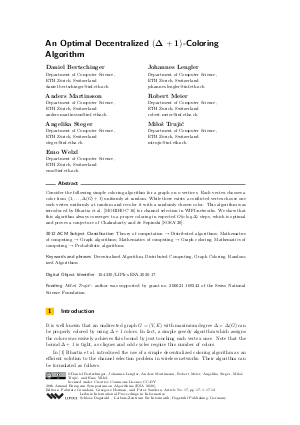An Optimal Decentralized (Δ + 1)-Coloring Algorithm
Authors Daniel Bertschinger, Johannes Lengler, Anders Martinsson, Robert Meier, Angelika Steger, Miloš Trujić, Emo Welzl
-
Part of:
Volume:
28th Annual European Symposium on Algorithms (ESA 2020)
Part of: Series: Leibniz International Proceedings in Informatics (LIPIcs)
Part of: Conference: European Symposium on Algorithms (ESA) - License:
 Creative Commons Attribution 3.0 Unported license
Creative Commons Attribution 3.0 Unported license
- Publication Date: 2020-08-26
File

PDF
LIPIcs.ESA.2020.17.pdf
- Filesize: 463 kB
- 12 pages
Document Identifiers
Subject Classification
ACM Subject Classification
- Theory of computation → Distributed algorithms
- Mathematics of computing → Graph algorithms
- Mathematics of computing → Graph coloring
- Mathematics of computing → Probabilistic algorithms
Keywords
- Decentralized Algorithm
- Distributed Computing
- Graph Coloring
- Randomized Algorithms
Metrics
- Access Statistics
-
Total Accesses (updated on a weekly basis)
0PDF Downloads0Metadata Views
Abstract
Consider the following simple coloring algorithm for a graph on n vertices. Each vertex chooses a color from {1, ..., Δ(G) + 1} uniformly at random. While there exists a conflicted vertex choose one such vertex uniformly at random and recolor it with a randomly chosen color. This algorithm was introduced by Bhartia et al. [MOBIHOC'16] for channel selection in WIFI-networks. We show that this algorithm always converges to a proper coloring in expected O(n log Δ) steps, which is optimal and proves a conjecture of Chakrabarty and de Supinski [SOSA'20].
Cite As Get BibTex
Daniel Bertschinger, Johannes Lengler, Anders Martinsson, Robert Meier, Angelika Steger, Miloš Trujić, and Emo Welzl. An Optimal Decentralized (Δ + 1)-Coloring Algorithm. In 28th Annual European Symposium on Algorithms (ESA 2020). Leibniz International Proceedings in Informatics (LIPIcs), Volume 173, pp. 17:1-17:12, Schloss Dagstuhl – Leibniz-Zentrum für Informatik (2020)
https://doi.org/10.4230/LIPIcs.ESA.2020.17
BibTex
@InProceedings{bertschinger_et_al:LIPIcs.ESA.2020.17,
author = {Bertschinger, Daniel and Lengler, Johannes and Martinsson, Anders and Meier, Robert and Steger, Angelika and Truji\'{c}, Milo\v{s} and Welzl, Emo},
title = {{An Optimal Decentralized (\Delta + 1)-Coloring Algorithm}},
booktitle = {28th Annual European Symposium on Algorithms (ESA 2020)},
pages = {17:1--17:12},
series = {Leibniz International Proceedings in Informatics (LIPIcs)},
ISBN = {978-3-95977-162-7},
ISSN = {1868-8969},
year = {2020},
volume = {173},
editor = {Grandoni, Fabrizio and Herman, Grzegorz and Sanders, Peter},
publisher = {Schloss Dagstuhl -- Leibniz-Zentrum f{\"u}r Informatik},
address = {Dagstuhl, Germany},
URL = {https://drops.dagstuhl.de/entities/document/10.4230/LIPIcs.ESA.2020.17},
URN = {urn:nbn:de:0030-drops-128837},
doi = {10.4230/LIPIcs.ESA.2020.17},
annote = {Keywords: Decentralized Algorithm, Distributed Computing, Graph Coloring, Randomized Algorithms}
}
Author Details
Funding
- Trujić, Miloš: author was supported by grant no. 200021 169242 of the Swiss National Science Foundation.
References
- Apurv Bhartia, Deeparnab Chakrabarty, Krishna Chintalapudi, Lili Qiu, Bozidar Radunovic, and Ramachandran Ramjee. IQ-Hopping: distributed oblivious channel selection for wireless networks. In Proceedings of the 17th ACM International Symposium on Mobile Ad Hoc Networking and Computing, pages 81-90. ACM, 2016. URL: https://doi.org/10.1145/2942358.2942376.
- Deeparnab Chakrabarty and Paul de Supinski. On a Decentralized (Δ + 1)-Graph Coloring Algorithm. In Symposium on Simplicity in Algorithms, pages 91-98. SIAM, 2020. URL: https://doi.org/10.1137/1.9781611976014.13.
- Benjamin Doerr and Leslie Ann Goldberg. Adaptive drift analysis. Algorithmica, 65(1):224-250, 2013. URL: https://doi.org/10.1007/s00453-011-9585-3.
- Benjamin Doerr, Daniel Johannsen, and Carola Winzen. Multiplicative drift analysis. Algorithmica, 64(4):673-697, 2012. URL: https://doi.org/10.1007/s00453-012-9622-x.
- Devdatt P Dubhashi and Desh Ranjan. Balls and bins: A study in negative dependence. BRICS Report Series, 3(25), 1996. URL: https://doi.org/10.7146/brics.v3i25.20006.
- Jun He and Xin Yao. A study of drift analysis for estimating computation time of evolutionary algorithms. Natural Computing, 3(1):21-35, 2004. URL: https://doi.org/10.1023/b:naco.0000023417.31393.c7.
- Timo Kötzing. Concentration of first hitting times under additive drift. Algorithmica, 75(3):490-506, 2016. URL: https://doi.org/10.1007/s00453-015-0048-0.
- Johannes Lengler. Drift analysis. In Benjamin Doerr and Frank Neumann, editors, In: Theory of Evolutionary Computation: Recent Developments in Discrete Optimization, pages 89-131. Springer International Publishing, Cham, 2020. URL: https://doi.org/10.1007/978-3-030-29414-4_2.
